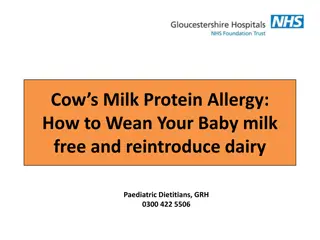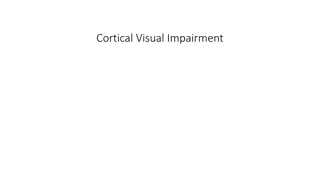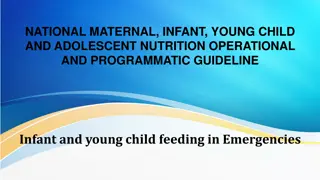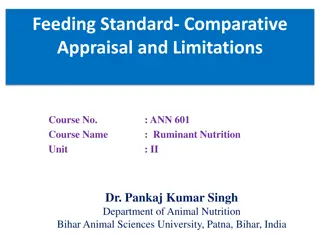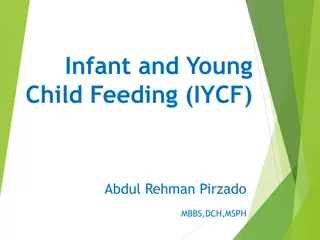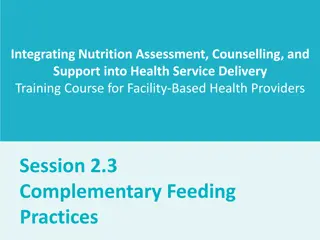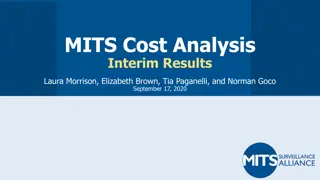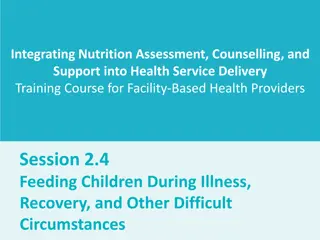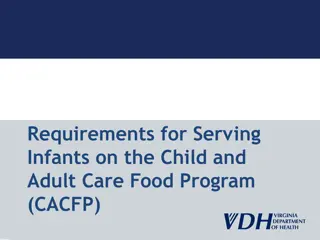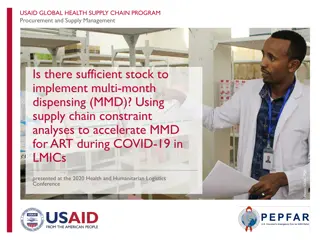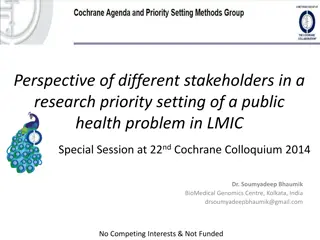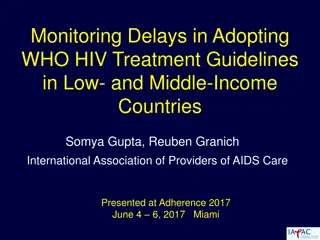Feeding Practices for LBW Infants in LMICs
Improved survival rates of small babies highlight the importance of nutrition for LBW infants. Research into feeding practices in LMICs is crucial for promoting growth and development. Studies compare formula milk to human milk, exploring effects on growth, development, morbidity, and mortality. Evidence shows potential benefits of breast milk fortification. Recommendations for optimal feeding for LBW infants are essential to prevent cognitive delays.
Download Presentation

Please find below an Image/Link to download the presentation.
The content on the website is provided AS IS for your information and personal use only. It may not be sold, licensed, or shared on other websites without obtaining consent from the author.If you encounter any issues during the download, it is possible that the publisher has removed the file from their server.
You are allowed to download the files provided on this website for personal or commercial use, subject to the condition that they are used lawfully. All files are the property of their respective owners.
The content on the website is provided AS IS for your information and personal use only. It may not be sold, licensed, or shared on other websites without obtaining consent from the author.
E N D
Presentation Transcript
SYSTEMATIC REVIEW: FEEDING PRACTICES FOR LBW INFANTS IN LMICS Abimbola Akindolire
Background Survival of small and very small babies have improved over the last 20 years. A large majority of preterms at term gestational age are growth restricted The main consequence of this growth restriction is reduced brain growth leading to cognitive delays. To prevent this, adequate nutrition must be started as early as possible. New research into best feeding practices in order to how to achieve the same intrauterine growth rates Most available research/reviews are from the HICs and current guidelines are based on these information
Literature search A literature search was conducted to see what evidence is available from LMICs to base current feeding practices on The questions we were asking at this time were What to feed How to feed When to start feeding How to advance
Literature search- what to feed Reviews comparing formula milk to human milk Henderson et al in 2007 compared formula milk and maternal breast milk The outcomes of interest were the effects on growth & development and morbidity & mortality No randomized control trials were found Henderson et al in 2007 compared nutrient enriched formula milk and human breast milk post-discharge The outcome of interest were the effects on growth & development, bone mineralization, feed intolerance, BMI and blood pressure on follow up No randomized control trials were found
Literature search- what to feed Review comparing formula milk to donor human milk Quigley 2014 9 studies -Europe 5, USA 3, Europe &USA 1; 5 studies term formula vs donor human milk and 4 studies preterm formula vs human donor milk 1070 babies- <1,800gm/32 weeks Outcomes of interest were effects on Growth & development. Incidence of adverse effects such as death, NEC, invasive infection and feed intolerance. Days to full feed. Quality of evidence was weak Main findings were increased short-term growth with formula but no effect on post-discharge growth or developmental outcomes. There was increased risk of NEC and feed intolerance in the formula fed population
Literature search Reviews on breast milk fortification Many reviews in HICs Most show evidence of improvement in weight gain with fortification
Author, year No. of studies Brown 20161 14 Setting No. of childr en Comparison Outcomes Quality of evidence Conclusion Europe 5, N. America 4, Asia 3, South Africa Sweden 1071 <2Kg Multinutrient fortified human milk vs unfortified human milk Supplementation of human milk with fat/MCT vs unsupplemented human milk Multinutrient fortification of human milk vs unfortified human milk post- discharge for 3-4 months Growth & development Weak Limited data Improved in- hospital growth Insufficient data Kuschel 2000 1 14 Growth & neurodevt. outcomes at 12-18 months. GI dist., feeding intolerance, diarrhoea, NEC Growth & devt. Duration of B/feeding. Bone mineralization. Rickets. Feed intolerance. Blood pressure on follow up Small numbers Young 20132 2 Canada & Denmark 246 Good but small numbers Limited data
Literature search Reviews comparing different types of formula feeds Author, year Basuki, 20137 2, India 1 fed preterm Setting N Comparison Outcomes QOE Conclusion 3-USA 102 Dilute vs full strength in exclusively formula NEC, wt gain. Feed tolerance, time to full feeds, LOHS Growth, BUN, IQ, abnormal phenylalanine levels, growth failure. Feed intolerance, days to full feed, NEC, sepsis, diarrhoea, metabolic acidosis Low to moder ate quality Weak Less feed intolerance less time to full feeds in the dilute strength. NEC not reported. Higher protein intake accelerates weight gain but limited data on long term outcomes. Insufficient evidence to make recommendations for very high protein formula. Fenton 20148 6-USA 3, UK 1, Netherl ands 1, Swede n 1 244 Higher ( 3g/kg/day but <4g/kg/day) vs lower (<3g.kg.day) protein in formula fed preterm or LBW infants 5 studies and 1 study with very high ( 4g/kg/day) vs high( 3g/kg/day but <4g/kg/day
Moon 20169 17-Mainly Europe, USA and Canada, multicentr e 2, Taiwan 1 8-USA 5, Netherlan ds 2, Canada 1 2,260 Longchain PUFA enriched formula vs standard formula Visual development, neurodevelop ment, growth Low Pooling of results showed no clear longterm benefits or harms of the intervention Nehra 200210 182 High vs low medium chain triglyceride content formula Short term growth, neurodevelo pment, longterm growth Little info on allocatio n method or blinding No evidence of difference in short term growth. Young 201611 16 Most in Europe, USA. 1 -S. Korea, Israel and Taiwan 1,251 Nutrient enriched vs standard formula post- discharge Growth, devt. Feed tolerance Bone mineralization BMI, Bp. Moderat e Limited evidence that use of preterm formula post-discharge may increase growth up to 18 months.
Literature review- When to start feeds Morgan, 2013, Trophic feeds vs fasting Primary outcomes Feed intolerance: days to establish full enteral feeding independently of parenteral nutrition. Necrotising enterocolitis Secondary outcomes All-cause mortality prior to hospital discharge. Growth Neurodevelopment Incidence of invasive infection Duration of phototherapy for hyperbilirubinaemia (days). Duration of hospital stay
Author Year N, Type of babies Country Intervention Ostertag 1986 38, <1500g North America >day4- day 7 Khayata 1987 12, <1500g North America Day 10 after birth Davey 1994 62, <2000g North America >Day4- day 7 Karagiami 2010 84, <35 weeks Greece >Day4- day 7 Pevez 2011 239, <1500g Colombia >Day4- day 7 Abdulma aboud 2012 125, <1500g Qatar >Day4- day 7 Leaf 2012 54, <35weeks UK/Ireland >Day4- day 7 Armanian 2013 82, <1500g Iran >Day4- day 7 Arnon 2013 60, SGA Preterms Israel >Day4- day 7
Literature search- How to advance Recommended is 30ml/kg/day What do we practice? Intuition or recommendation? Oddie, 2017 looked at if daily increments of 15 to 20 mL/kg (compared with 30 to 40 mL/kg) reduces the risk of NEC or death in very preterm or VLBW infants, extremely preterm or ELBW infants, SGA or growth-restricted infants, or infants with antenatal AREDFV A total of 3753 infants from 10 studies
Authors Year weight Setting Intervention Rayyis 1999 <1500 N. America 15 vs 35 Caple 2004 1000-2000 N. America 20 vs 35 Salhotra 2004 <1250 India 15 vs 30 Krishnamurthy 2010 1000-1500 India 20 vs 30 Karagol 2013 750-1250 Turkey 20 vs 30 Raban 2014a <1001g S Africa 24 vs 36 Raban 2014b <1001 S Africa 24 vs 36 Modi 2015 750-1250 India 15- 20 vs 30- 40 SIFT 2016 <1500g UK/Ireland 18 vs 30 Jaih 2016 1000- 1249 India 20.s 30
Literature search- How to advance Slow advancement does not reduce the risk of NEC on All and all the subgroups Formula fed - Rayyis 185 infants, 1 study Infants who were at least partially fed with human milk- 9 studies, 3557 infants Extremely preterm/ELBW- 5 studies, 1299 infants Infants with IUGR- 2 studies 639 infants Infants with absent/ reversed end diastolic flow velocity- 2 studies, 465 infants. Mortality- no effect on risk of mortality on all infants and all subgroups Infants who had fast advancement achieved full enteral feeds and regained birth weight faster than those in the slow group Incidence of LOS was higher in the slow advancement group No conclusive evidence on length of hospital stay Quality of evidence was moderate downgraded from high because of lack of blinding
Literature search- How to feed Continuos vs bolus Push vs gravity NG vs OG Bottles??
How to feed-Nasal versus oral route for placing feeding tube Watson et al, 2013 -3 studies Van someren 1984, 42 babies, 30 to 34weeks Apnoea, Weight gain- no difference Dsilna, 2005 46 <30 weeks/<1200 time to full enteral feeds and regain birth weight and incidence of adverse events Bohnhurst 2010, 35 No significant differences in adverse events time to independence from supplemental oxygen, time to full enteral feeds time to full oral feeds not reported Statistical significant difference in weight gain in NG 0.6vs OG 8.3g/kg/day in 1stweek none after Data not sufficient for policy Decision based on clinicians preference A large RCT needed to compare
How to feed- Continuous versus bolus Shahirose 2011, 7 RCTs, 511 preterm infants less than 1500gmi No significant difference in growth and incidence of NEC but earlier discharge in ELBW fed by continuous nasogastric feeding Quality of evidence is weak
How to feed- Push versus gravity Dawson 2013, looked at the evidence that gravity feeding results in a more rapid establishment of full gavage feeds without increasing adverse events in preterm or low birth weight, or both, infants who require intermittent bolus tube feeding Only one small trial- N 31,<32 weeks No significant difference in heart rate at completion of feeds Difficult to conclude
WHO Recommendations on optimal feeding of very low- birth- weight infants What to feed? Choice of milk Mother s milk*, Donor human milk** Standard formula but if they fail to gain weight -Preterm formula No routine human milk fortifiers except they fail to gain weight Supplements ALL- Vitamin D On human milk-Calcium, phosphorus- unclear for how long; iron from 2 weeks-6 months
WHO Recommendations on optimal feeding of very low- birth- weight infants Daily vitamin A is not recommended due to lack of evidence When and how to initiate feeding 1stday of life 10ml/kg the remaining fluid requirement should be by IV Fluid How to feed? Not clearly how to feed just that in VLBW who need intragastric tube it should be by oral/nasal route How to advance Up to 30ml/kg/day careful monitoring for feed intolerance

 undefined
undefined





